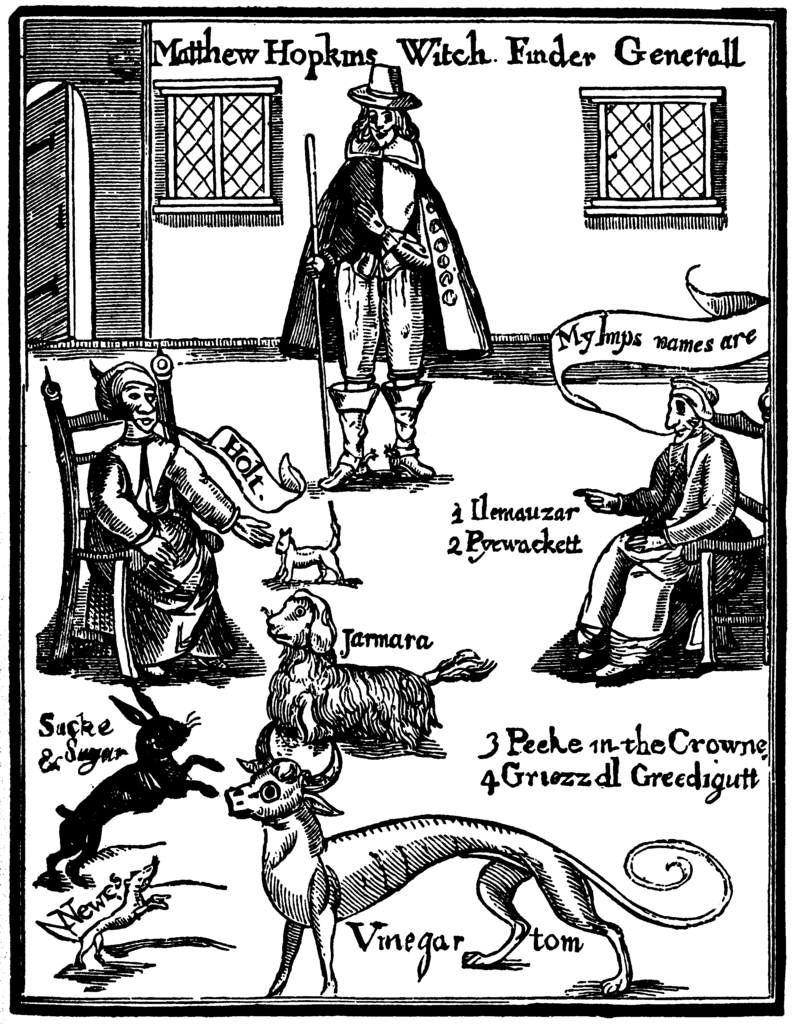It’s a mystery exactly when and where Matthew Hopkins was puttering around before 1644, but when he did arrive on the scene, it was with a bang.
A few decades before the Salem Witch Trials in the US, witch hunts were already going strong in the UK. As previously mentioned in my article Signs You Might’ve Signed the Devil’s Book in the 16th Century, men and women (but mostly women) were being accused left and right of witchcraft, usually based in ideologies we now consider silly.


Any person who was considered unlikeable, friendly with other suspicious persons, or even just acting “a little peculiar,” was certainly in cahoots with the devil and needed to be taken care of, for the sake and safety of the rest of the village. I don’t even want to think about what life would be like if the stigma surrounding mental illness wasn’t continuing to gradually change over time, and was still considered a symptom of “demonic possession” or something similarly ridiculous.
But Matthew Hopkins, in all his youthful wisdom, took witches very, very seriously. He found it to be his life’s purpose, bestowed upon him by God, to find and dispose of all witches he could— or, at least in his general area. This area consisted of villages and towns within about 10 miles of his hometown of Great Wenham in Suffolk, including Essex, Norfolk, and Huntingdon.
Accompanied by his partner, John Stearne, Hopkins’ witch-hunting crusade began in 1644 and continued until 1646, before his eventual retirement in 1647. During this time, it’s predicted that he influenced between 200-300 executions of supposed witches, either committed by himself or through others inspired by his work.

This is particularly heinous when considering that between the early 15th and late 18th centuries, there were a total of 500 witchcraft-based executions total. This means, if the number of his 300 victims is correct, his work alone accounts for 60 percent of all deaths.
Despite the illegality of using torturous methods to influence a confession, Hopkins was known to partake in trials by water, pricking, and sleep-deprivation — three methods previously mentioned in the last installment of Witchy Wednesday. Naturally, by way of how unfair and ineffectual these methods were for supporting an accused person’s innocence, his success rate of “unveiling witches” was so profound that soon he was a celebrity in the world of witch-hunting.
Such came the title he gave himself: “Witch Finder General.” If you think sounds like the name a six year old would give himself during a rigorous playdate in the backyard of his mom’s house, you’re almost right— it’s speculated that Hopkins was around age 22 when his crusade began. The name was never even sanctified by the church or British Parliament, which makes it even more ridiculous. Calm down, boy.
According to his book The Discovery of Witches (which is available as a free eBook), his interest in hunting witches began when he purportedly overheard a group of women discussing their conversations with the devil in 1644, in the town of Manningtree. This ultimately lead to the accusation and trials of 23 women in 1645. Four died in prison, while the other 19 were hanged. Off to a strong start there, bud.
Another documented victim was named Elizabeth Clarke, a one-legged widow who Hopkins claimed was a little too familiar with her familiars. The familiar argument always gets me, and I think about it every time I walk through my front door and call out to my cat. Do more familiars make a witch more powerful? What kind of magic could I perform with 10 cats? What about this woman whose husband divorced her because of her 550 cats? I think she might be our Witch Supreme.

But, I digress. Elizabeth Clarke was subjected to sleep deprivation, walked back and forth night after night, until eventually she broke down and confessed. All of this, because it was thought witches could only correspond with their familiars while well-rested— which also makes no sense, because even my cat keeps me up all night with her excitability.
Eventually, Elizabeth Clarke was hanged, and there began Hopkins’ career as Witch Finder General.
As mentioned above, his campaign continued until his retirement in 1647, where it’s suspected one of two things happened to him:
- He himself was accused of practicing witchcraft, subjected to a trial by water, and subsequently drowned (implying he was innocent!)
- More likely, though: he died of an illness, probably tuberculosis. Less ironic, but that’s fine.
Witch trials of the early centuries are admittedly both historically appalling and intriguing— but the fact that so many people were able to profit off of them turns them from being situations of unfortunate mass panic to events that were seemingly forced to continue in order to fill the pockets of those profiting off of them. Had there not been so many people taking advantage of the entire affair, such as Matthew Hopkins, one has to wonder if the witch-hunting sensation would’ve lasted as long.
Want to read more on Matthew Hopkins? Check out these links!:
Journal of the Witch Finder General Opened Up
Kelsey graduated from Boise State University with a BA in Visual Arts, and is currently working as a freelance writer, while doodling anime on the side with one hand and petting cats with the other.
